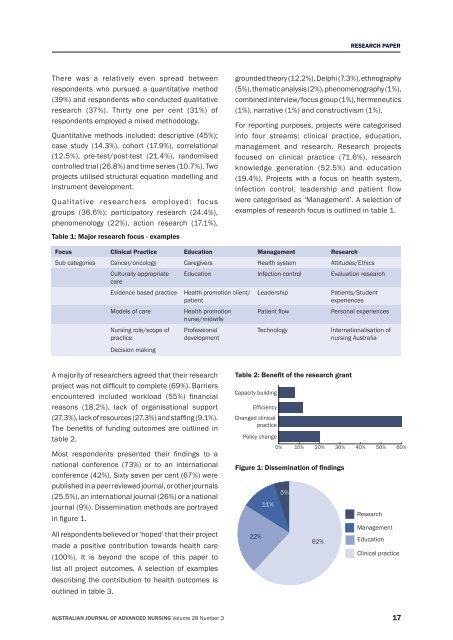australian journal of advanced nursing
australian journal of advanced nursing
australian journal of advanced nursing
Create successful ePaper yourself
Turn your PDF publications into a flip-book with our unique Google optimized e-Paper software.
There was a relatively even spread between<br />
respondents who pursued a quantitative method<br />
(39%) and respondents who conducted qualitative<br />
research (37%). Thirty one per cent (31%) <strong>of</strong><br />
respondents employed a mixed methodology.<br />
Quantitative methods included: descriptive (45%);<br />
case study (14.3%), cohort (17.9%), correlational<br />
(12.5%), pre‑test/post‑test (21.4%), randomised<br />
controlled trial (26.8%) and time series (10.7%). Two<br />
projects utilised structural equation modelling and<br />
instrument development.<br />
Qualitative researchers employed: focus<br />
groups (36.6%); participatory research (24.4%),<br />
phenomenology (22%), action research (17.1%),<br />
Table 1: Major research focus ‑ examples<br />
RESEARCH PAPER<br />
grounded theory (12.2%), Delphi (7.3%), ethnography<br />
(5%), thematic analysis (2%), phenomenography (1%),<br />
combined interview/focus group (1%), hermeneutics<br />
(1%), narrative (1%) and constructivism (1%).<br />
For reporting purposes, projects were categorised<br />
into four streams: clinical practice, education,<br />
management and research. Research projects<br />
focused on clinical practice (71.6%), research<br />
knowledge generation (52.5%) and education<br />
(19.4%). Projects with a focus on health system,<br />
infection control, leadership and patient flow<br />
were categorised as ‘Management’. A selection <strong>of</strong><br />
examples <strong>of</strong> research focus is outlined in table 1.<br />
Focus Clinical Practice Education Management Research<br />
Sub categories Cancer/oncology Caregivers Health system Attitudes/Ethics<br />
Culturally appropriate<br />
care<br />
Evidence based practice Health promotion client/<br />
patient<br />
Models <strong>of</strong> care Health promotion<br />
nurse/midwife<br />
Nursing role/scope <strong>of</strong><br />
practice<br />
Decision making<br />
Education Infection control Evaluation research<br />
Pr<strong>of</strong>essional<br />
development<br />
A majority <strong>of</strong> researchers agreed that their research<br />
project was not difficult to complete (69%). Barriers<br />
encountered included workload (55%) financial<br />
reasons (18.2%), lack <strong>of</strong> organisational support<br />
(27.3%), lack <strong>of</strong>resources (27.3%) and staffing (9.1%).<br />
The benefits <strong>of</strong> funding outcomes are outlined in<br />
table 2.<br />
Most respondents presented their findings to a<br />
national conference (73%) or to an international<br />
conference (42%). Sixty seven per cent (67%) were<br />
published in a peer reviewed <strong>journal</strong>, or other <strong>journal</strong>s<br />
(25.5%), an international <strong>journal</strong> (26%) or a national<br />
<strong>journal</strong> (9%). Dissemination methods are portrayed<br />
in figure 1.<br />
All respondents believed or ‘hoped’ that their project<br />
made a positive contribution towards health care<br />
(100%). It is beyond the scope <strong>of</strong> this paper to<br />
list all project outcomes. A selection <strong>of</strong> examples<br />
describing the contribution to health outcomes is<br />
outlined in table 3.<br />
Leadership Patients/Student<br />
experiences<br />
Patient flow Personal experiences<br />
Technology Internationalisation <strong>of</strong><br />
<strong>nursing</strong> Australia<br />
Table 2: Benefit <strong>of</strong> the research grant<br />
Capacity building<br />
Efficiency<br />
Changed clinical<br />
practice<br />
Policy change<br />
Research<br />
Management<br />
Education<br />
Clinical practice<br />
AUSTRALIAN JOURNAL OF ADVANCED NURSING Volume 28 Number 3 17<br />
22%<br />
11%<br />
0% 10% 20% 30% 40% 50% 60%<br />
Figure 1: Dissemination <strong>of</strong> findings<br />
5%<br />
62%

















